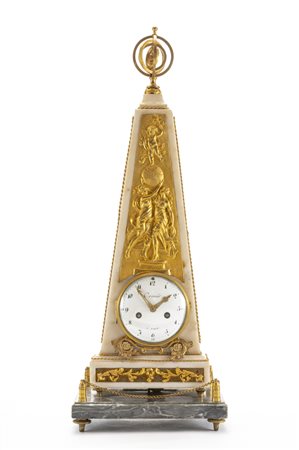 Lucas - Via Nino Bixio 32, 20129 Milano
Lucas - Via Nino Bixio 32, 20129 Milano
ARGENTI, DIPINTI, ICONE ED OGGETTI D'ARTE ARGENTI, DIPINTI, ICONE ED OGGETTI D'ARTE
lunedì 19 aprile 2021 ore 15:00 (UTC +01:00)
Orologio Luigi XVI in forma di obelisco
Importante e raffinato orologio Luigi XVI in forma di obelisco. In marmo bianco, con decorazioni in bronzo dorato al mercurio e poggiante su una base in marmo grigio su quattro piedini dorati, sormontato da sfera armillare. Il fronte riccamente decorato da lamina in bassorilievo con figure allegoriche: un putto al di sopra di un globo, sostenuto da due fanciulle danzanti, in vesti classiche. Quadrante in smalto bianco, con ore in dodici e minuti di cinque in cinque, entrambi in cifre arabe, firmato Cronier à Paris in rosso. Elegantissime lancette Luigi XVI. I lati dell’obelisco sono profilati con una sottile funicella metallica dorata intrecciata. Ai quattro spigoli della base in marmo grigio, quattro elementi reggono una catenella dorata a protezione dell’obelisco. Movimento con suoneria delle ore e delle mezze, su una campana.
Per due esemplari simili in letteratura, si veda: "Pierre Kjellberg, Encyclopédie de la Pendule Française du Moyen Age au XXeme siècle", p. 219 (a e b).
Antoine Cronier, o Crosnier (1732-1806), fu celebre orologiaio francese, apprendista presso Thuillier ed orologiaio indipendente a partire dal 1753. Riconosciuto Maître Horloger nel 1763, le sue opere si avvalsero dei migliori bronzisti della seconda metà del XVIII secolo e compaiono oggi nei più importanti musei, quali il Musée Nissim de Camondo di Parigi, la Royal Collection britannica, il Waddesdon Manor, la Harewood House, il Residenzmuseum di Monaco di Baviera, la Neue Residenz di Bamberg, il Palazzo Reale di Torino, il Nationalmuseet di Stoccolma, il Boston Museum of Fine Arts, la Huntington Library e il Palazzo di Pavlovsk
An important and fine Louis XVI clock in the shape of an obelisk. White marble, with fine ormolu decorations, on a grey marble pedestal on four ormolu feet, topped by an armillary sphere. The front is richly decorated by an ormolu bas-relief with allegorical figures: a putto over a globe, sustained by two female dancers, in classical dresses. The dial is white enamel, hours are in twelve and minutes are five to five, both in Arabic numerals. The dial is signed Cronier à Paris, in red. Very elegant Louis XVI hands. A gilt twisted string surrounds the marble sides of the obelisk and some of the brims. The grey marble pedestal has four ormolu elements carrying a gilt chain, surrounding the obelisk. The movement strikes hours and half hours, on a bell.
For two similar clocks in horological literature, see:"Pierre Kjellberg, Encyclopédie de la Pendule Française du Moyen Age au XXeme siècle", p. 219 (a and b).
Antoine Cronier, or Crosnier (1732-1806), was a famous French clockmaker. Apprenticed to Thuillier, he became an independent maker in 1753, to become a Master Clockmaker in 1763. His clocks were used by the best bronze casemakers of the second half of the 18th century and are in the most important museums and collections all over the world, among which Musée Nissim de Camondo in Paris, the Royal Collection in UK, Waddesdon Manor, Harewood House, the Residenzmuseum in Munich, the Neue Residenz in Bamberg, the Royal Palace of Turin, the Nationalmuseet of Stockholm, the Boston Museum of Fine Arts, the Huntington Library and the Palace of Pavlovsk
Altezza 56 cm


